
Toilets In Motion — Submarine Toilets
Submarine Toilets
Just like surface ships, the toilet on board a submarine is referred to as its head out of traditional maritime custom. Compared to their surface cousins, submarines have a much more difficult time dealing with mundane operations including flushing the toilet. During the last month of World War II, a German U-boat was lost due to problems with its toilet.
The captain of the U-1206 wanted to use the toilet, and did so without the assistance of one of the on-board engineers qualified in the operation of that particular toilet. The resulting mishap threatened to poison the crew with chlorine gas and forced the submarine to surface during the daytime near the coast of Scotland. It was quickly spotted by a British aircraft which attacked the sub and damaged it badly enough that it was unable to safely dive.
The captain scuttled the submarine, just 10 days into the only real combat patrol for both the submarine and its captain, and just over two weeks before Hitler's suicide leading to Germany's surrender 8 days later.
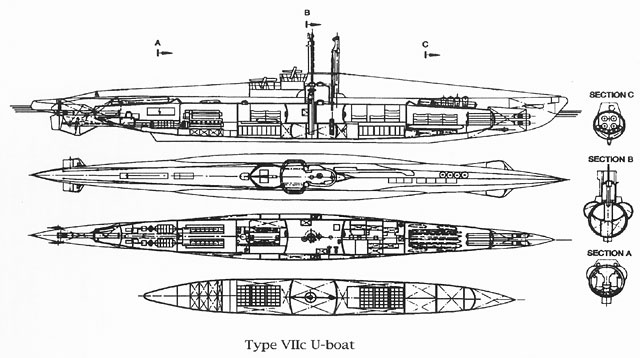
Cross-section diagrams of a German Type VIIc U-boat.
Nazi Germany and U-Boats
Nazi Germany's Kriegsmarine (or Navy) built and operated submarines. The German term Unterseeboot (or "Undersea boat"), commonly shortened to U-Boot is used as a generic term for any submarine. The English version, U-Boat, refers exclusively to German military submarines, especially those of the First and Second World Wars.
The Paris Peace Conference of 1919 led to the Treaty of Versailles and its restriction of the size of the German surface fleet and outright prohibition of German submarines. Germany soon established a submarine design office in the Netherlands, a torpedo research program in Sweden, and concealed other submarine construction under the cover of "research" or other ruses.
After Germany had been caught running these illegal submarine projects, the Anglo-German Naval Agreement of June 1935 attempted to regulate the size of the German Kriegsmarine in relation to that of the U.K.'s Royal Navy. The German surface fleet was not to exceed 35% the tonnage of the Royal Navy, while it would be allowed a submarine tonnage equal to that of the entire British Commonwealth of Nations.
Germany, of course, exceeded the limits all around, and Adolf Hitler renounced the agreement on 28 April 1939, just over 4 months before Germany started World War II in Europe by invading Poland. At that point Germany had 65 U-boats, and 21 of them were at sea and ready for war when the war began on 1 September 1939.
The Type VII series of U-boat was the most common during the war. There were 10 Type VIIA subs built in 1936 and 1937, then 24 Type VIIB subs built between 1936 and 1940, each with an added 33 tonnes of fuel (and another 2,500 nautical miles of range), increased speed and manuverability, and an upgrade from 11 to 14 torpedos.
The Type VIIC was the core of the German submarine force. 568 Type VIIC U-boats were launched between 1940 and the last one, the U-1308, launched in November 1944 and commissioned 17 January 1945.
The U-1206
The U-1206 was built at the Schichau-Werke yard in Danzig (now Gdańsk, Poland). It was laid down on 12 June 1943, launched on 30 December 1943, and commissioned on 16 March 1944.
A few months later, the Germans began forcing Jewish prisoners from Poland, France, Netherlands, Lithuania, Latvia, Germany, and Hungary held at the nearby concentration camp KL Stutthof to work 12-hour shifts at Schichau-Werke. They were allowed just a half litre of watery soup and 250 grams of bread during the day and another half-litre of soup after work, were not given adequate clothing in winter, and died in large numbers due to workplace accidents, epidemics, and beatings by the guards.
The U-1206 was commissioned under Oberleutnant zur See Günther Fritze and deployed in training exercises with the 8th U-boat Flotilla from March until June 1944, when it was assigned to the 11th U-boat Flotilla and Kapitänleutnant Karl-Adolf Schlitt took command.
What is aToilet
Snorkel?
The German Kriegsmarine adapted a Dutch naval innovation from the late 1930s, the snuiver (or "sniffer"). This was a device that brought in air for the diesel engines while the submarine itself was submerged. The device was renamed a schnorkel and widely installed on Nazi submarines during the last year of the war. The U-1206 had one added when it was assigned to the 11th U-boat Flotilla.
By the time the snorkel was fitted and tested, it was well into the spring of 1945 and the end of the war was in sight. The snorkel was of mixed benefits. A sub running submerged on diesel power relying on the snorkel was limited to a speed of six knots, in order to avoid breaking the snorkel's air tube extended at a right angle through the water. The "feather" kicked up by the snorkel was visible over a long distance. Early radar systems could detect periscope tips, and snorkels were at least as large a radar target. UK radar systems of 1940 could detect a submarine periscope from a half-mile away.
The worst thing for the crew was when a larger wave caused the snorkel's automatic valves to slam shut. The diesel engines would suddenly begin drawing air from within the boat, causing a partial vacuum that sometimes led to ruptured eardrums.
First Patrol of the U-1206
The U-1206 departed Kiel on 28 March 1945 on a two-day training patrol in the North Sea. It returned to port at Horten Naval Base on the 30th.
Second Patrol of the U-1206
The second training patrol was shorter, just one day. It left Horten on 2 April 1945 and put in at Kristiansand on the next day, the 3rd.
Third and Final Patrol of the U-1206
The U-1206 departed from Kristiansand on its first active patrol on 6 April 1945. It headed into the North Sea, between Britain and Scandinavia.
The Loss of the U-1206
Eight days into its only combat patrol on 14 April 1945, the U-1206 was cruising at a depth of 200 feet off the coast of Scotland. The Type VIIc design had a test depth of 230 meters (or 750 feet), and an estimated crush depth of 250–295 meters (or 820–968 feet). They were just 8 nautical miles off the easternmost tip of the coast of Scotland at Peterhead, in Aberdeenshire.
Captain Schlitt decided that he needed to use the toilet. The U-1206 had a new toilet design, intended to support operation at greater depth and thus exterior pressure. But a new design is an unfamiliar one, and he called for assistance. The specialist who arrived was also unfamiliar with the details of the new toilet design, as only some of the engineering ratings had been fully trained in the operation of the new toilet design. He opened the wrong valve and salty seawater started pouring into the submarine and flooding the battery compartment.
Basic chemistry time:
Water is H2O and salt is NaCl. Dissolve salt in water and you get an solution of Na+ and Cl– ions. Pure H2O isn't conductive, but an ionic solution certainly is. And diesel-electric submarines carry battery banks with enormous capacity. They provide 560 kilowatts of power for propulsion submerged.
| H2O + Na+ + Cl– + sub battery | → | H2O + NaOH + Cl2 + H2 |
Oh, my. Water plus lye plus chlorine gas plus hydrogen gas.
Chlorine gas is a deadly poison, and recall Germany's earlier misadventure with hydrogen and the LZ 129 Hindenburg at U.S. Naval Air Station Lakehurst, New Jersey. Oh, the humanity.
Time to air out the boat, fast.
The submarine had to surface to clear the chlorine gas out of the air. Unfortunately, this was during the daytime and a British coastal patrol aircraft happened to be flying nearby. The U-1206 crew was managing to blow good air in and poisonous and explosive gases out, but meanwhile they were under fire from the British plane. One man was killed during the aerial attack, and the submarine was damaged to the point it couldn't safely be submerged.
Kapitänleutnant Karl-Adolf Schlitt ordered that the code books should be thrown overboard in the weighted bags brought along for exactly that purpose, the scuttling valves should be opened, and the men should abandon ship. Three men drowned in the heavy seas while abandoning ship.
Schlitt recorded that the sub was scuttled at 57°24'N 01°37'W, but later searches didn't find anything.
Karl-Adolf was taken ashore in Britain, treated kindly, returned home after the war, and survived to die at the age of 90 on 7 April 2009.
AdolfHitler's
toilet
On 30 April 1945, just sixteen days after the loss of the U-1206, Adolf Hitler committed suicide. Germany unconditionally surrendered on 8 May 1945.
In the 1970s, survey work for the BP Forties Field oil pipeline stumbled across the remains of the U-1206 at 57°21'N 01°39'W in approximately 70 meters (or 230 feet) of water.
Toilets of the Nuclear Age
Many systems are greatly updated in this era of nuclear navies. Propulsion, navigation, communications, and certainly the weapons. The heads, not so much.
The USS Will Rogers (SSBN-659) was a Benjamin-Franklin-class ballistic missile submarine in the U.S. Navy, in service from April 1967 through November 1992. Nuclear powered, carrying 16 ballistic missiles. She was scrapped via the U.S. Navy's recycling program, but some components were saved for the National Museum of the U.S. Navy at the Washington Navy Yard.
This includes the commode from the chief's head.
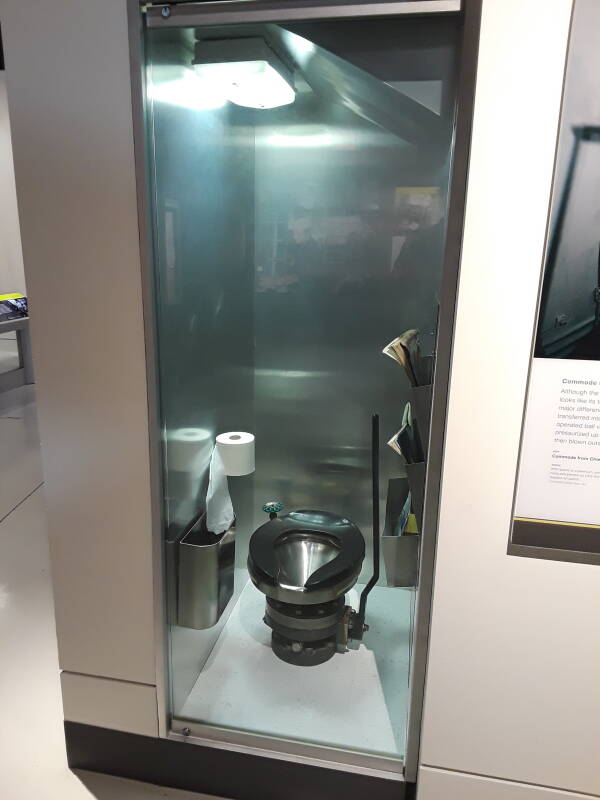
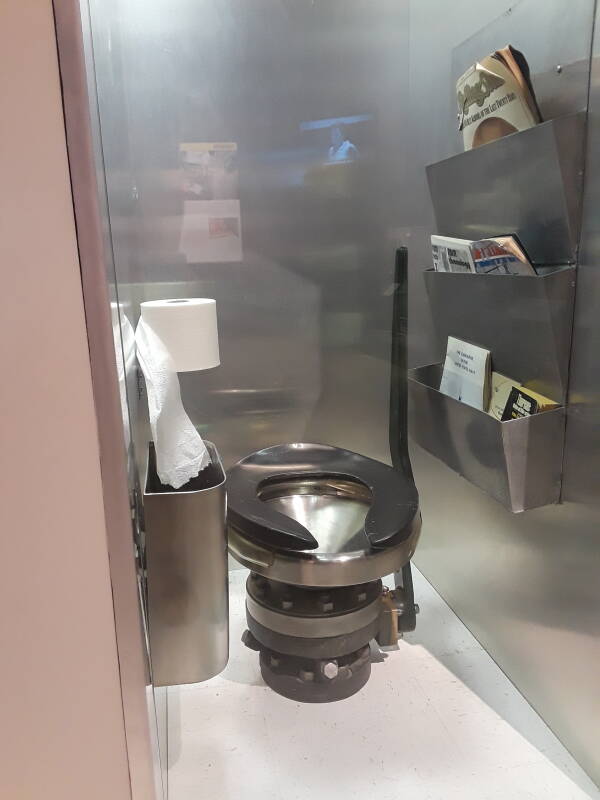
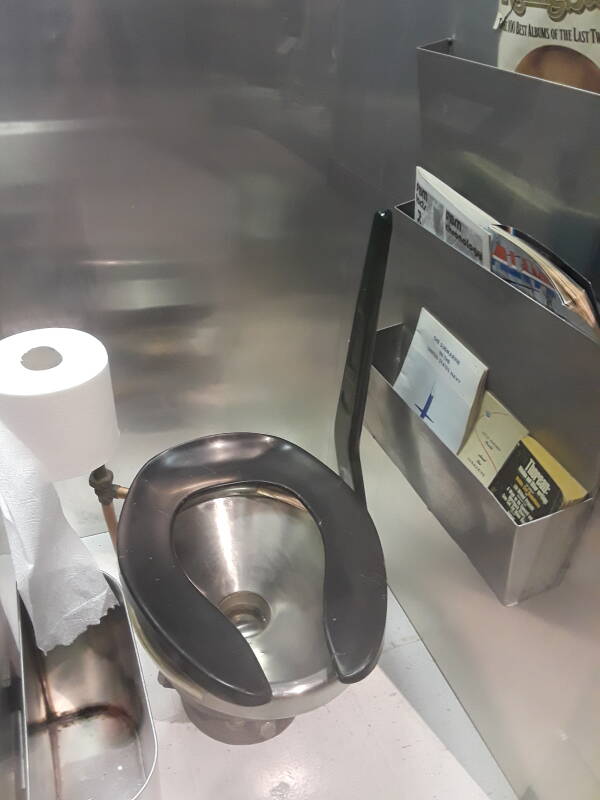
The long lever operates a ball valve that drains the toilet into a holding tank. The holding tank can then be pressurized up to 700 psi to blow the waste outside the pressure hull. That should be adequate pressure to blow the holding tank down to a depth of 493 meters or 1618 feet.
Toilet Sea Stories
Here are two wonderful sea stories I received from Jay Arnot, MM2/OTA1 1978-1991. He found my site while searching for information on DC-3 and 1940s train toilets "and saw your submarine data was a little sparse."
Shit on by the US Navy
Piping onboard US Navy vessels is color coded. White for steam, two different shades of blue for potable water and feed water, Alternating yellow and black for lube oil. You can guess what gold piping is for... Yup, you guessed it. Collection, Holding and Transfer (CHT).
Onboard submarines the ball valve used to isolate crappers and urinals are called flapper valves. If a sailor is going to blow sanitaries overboard, they go around to all the heads, close the flappers (should be closed anyway), and hang signs that say "DO NOT USE, BLOWING SANITARIES".
A wise sailor learns to just crack the flapper open, and if a blast of air issues, close it quickly. Stories abound of a junior non-rate failing to hang a sign, and an incautious shipmate getting an outline blown on the wall behind them. It is no coincidence that the walls in the heads are made of stainless steel.
Surface ships use gravity fed systems and pumps, they do not run the same risks.
However, I have a couple of unique stories to tell. I was a RadCon (Radiological Controls) technician At SubBase Pearl Harbor in the early 1980s. A floating drydock had recently transferred to the base, and had a nuclear submarine in for repairs. As the duty monitor that day, I was going around checking every radiation area on the base. I had a radio, two radiac meters, and clipboard with maps. One of the areas needing my attention was the drydock floor around the submarines reactor.
While conducting my survey, I heard high pressure air cutting loose somewhere, and was quickly looking around for any flailing air hose that might hit me, nothing was flailing. The sound was hard to focus in on as it was echoing around the metal walls of the dock, but I determined it was coming from a fitting on the port side of the boat, forward of the reactor. I was initially panicked, thinking it was CD-4 (Coolant Discharge Valve #4), but them remembered that all coolant discharge fittings were on the starboard side on this class of boat. I walked up even with it, about 30 feet above me wondering what this fitting was?
The sound went from a high pitched hiss to a low pitched gargle, and I found out. I turned, and it was hitting me squarely between the shoulder blades. With my eyes shut, I duck walked forward out of the direct blast, dug out a clean piece of t-shirt under my uniform, and wiped my eyes, nose, mouth and the rest of my face. This submarine had two CHT fittings, one FWD, one AFT. The drydock hose was connected to the FWD fitting, douchebag had blown aft. I knew I should stand fast and not spread contamination, but I was pissed. I walked (squished) forward until I made the 3 story ladder to the drydock wall, climbed the ladder to the drydock quarterdeck, saluted the flag and proceeded aft to the brow (gangplank) to the submarine. Once out of the metal box of the drydock I pulled my radio and called home base for assistance.
"QUICKDRAW THIS IS QUICKDRAW FOUR"
"THIS IS QUICKDRAW"
"I NEED A SET OF ANTI-Cs AND THE DEUCE AND A HALF AT THE FLOATING DRYDOCK" I have just asked for a yellow anti-contamination suit used during a radiological spill.
"DO WE HAVE AN EVENT?" More information please, I'm about to press the panic button.
"NEGATIVE, THIS IS NOT, REPEAT NOT, A RADIOLOGICAL EVENT, BUT I NEED THE ANTI-Cs AND THE TRUCK. BRING A BUNCH OF LARGE GREEN POLY BAGS & TAPE. I WILL EXPLAIN ON THE PIER."
"ALSO, CALL MY WIFE, HAVE HER BRING ME A NEW UNIFORM. SHIRT, PANTS, UNDERWEAR, T-SHIRT, SOCKS, BOOT, BELT — E V E R Y T H I N G".
"ROGER".
I went across the brow, saluted the flag, did not salute the armed guard, but growled at him and said "Get the fuck out of my way". I went to the forward(torpedo) hatch, climbed down into the boat and dripped shit as I worked my way aft yelling "Who blew sanitaries into the drydock floor? I want somebody's ass". Several ships officers and chiefs intercepted me amidships, and ordered me out the midships hatch. One of them said they guy who did it already ran off the boat and down the pier and for me to leave. I left, and my crew was waiting for me on the pier as I exited the drydock. I stripped pierside, put on the anit-Cs and stepped into the green poly bags. (Yellow indicates radioactives, green is "clean".)
They drove me to medical where I took several showers and deep cleansings, plus a bunch of booster shots.
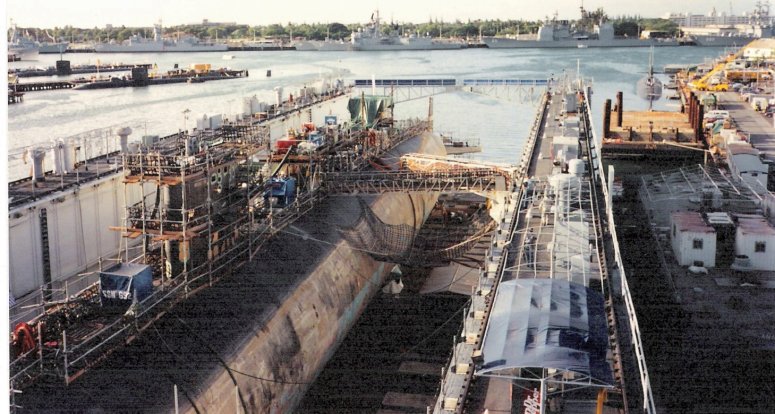
Attached is a picture of the boat in the floating drydock, moored at S19 & S20 of Sub Base Pearl. The aft CHT fitting was just below where the yellow service boom contacts the hull. The fwd CHT fitting (which had the hose attached) was just aft of the sonar dome collision mat, down by the keel.
Shit on by the US Navy, Part Two
Almost three years later and 900 yards SW, I am assigned to a destroyer. DDG-16 is an old hunk of junk, but she's also the fastest hunk of junk in the harbor. The heat in the M&B berthing compartment is oppressive, particularly when the FNG (Fucking New Guy), me, is assigned a top rack. Jorgensen was accommodating and lets me use a corner of his mattress as a pillow, as I slept on the steel access hatch going down into the pump room. One morning we wake up to a horrible stench in berthing. The engineers head is directly above us, and we are looking into the overhead, thinking it is coming from there.... Nope no leaks, no weeps, no plastic deformations.. Then we realize the CHT is serviced by the pump room. We open the hatch scuttle, and find that the pump room is now a CHT tank. This is not a Main Propulsion system, The A-Gangers & Electricians are going to clean this one up.
We arrange for a floating tank to be brought alongside, and rig a damage control pump to take a suction on the pump room. Now who's going to be the lucky guy to hold the discharge end of that hose? I know this drill, and I've had my booster shots. I volunteer and change into my shittiest :) working uniform.
Turns out a CHT line ruptured, tripped a pressure sensor, and the CHT pump filled the pump room until the golden flow shorted out the controller located within 18" of the ceiling.
And so I was shit on by the US navy, twice.
Separate item, I've seen red toilets for use by the guys with venereal disease. If you're seeing Doc for a case of the clap, you use the red shitter.
All shipboard toilets up through 1990 used salt water for flushing (not sure about the new Arleigh Burke Class). Fresh water was saved for drinking, feedwater for the boilers, and showers for the cooks. If the boilers were leaking and we planned to be out longer than a week, we would secure the drinking fountains.
Once a week I would steal half a bucket of feed water from the main condenser for a bath.
Amazon
ASIN: 1574885308
Amazon
ASIN: 1591145996